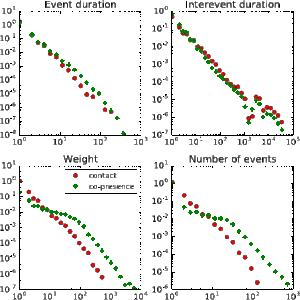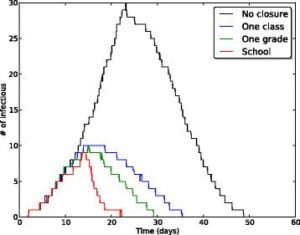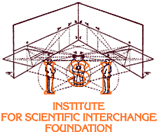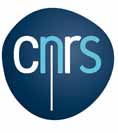DEPLOYMENT: Infectious SocioPatterns
Event descriptionThe mission of the Science Gallery at the Trinity College in Dublin is to ignite creativity and discovery where science and art collide. It opened its doors in February 2008 and has since offered a changing programme of exhibitions, festivals and experiences. In 2009 the Science Gallery held four exhibitions, one of which was INFECTIOUS: Stay away. This exhibition investigated mechanisms of contagion and strategies of containment through science and art. It ran for three months. 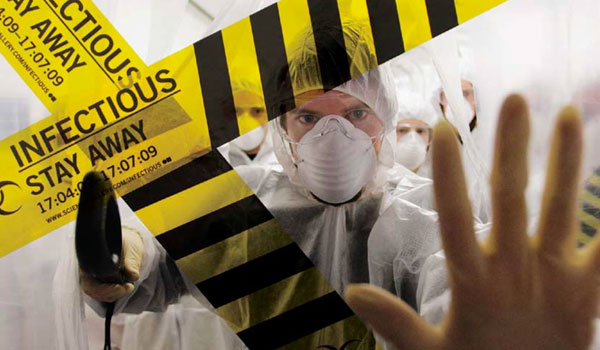 Promotion image for INFECTIOUS exhibition. INFECTIOUS teaser movie.
Deployment descriptionContributing to a better understanding of the spreading of infectious diseases has always been one of the research objectives of the SocioPatterns project. Given a human-to-human contact network, researchers can perform data-driven computer-based simulations of human-to-human infection spreading over that network. While the study of such infection dynamics considering the complex topology of cumulative contact networks is not new, the SocioPatterns project aims to contribute by enabling such studies on detailed datasets on physically grounded person-to-person contact that include the temporal dimension, allowing researchers to consider the causal order of contacts. When the Science Gallery learned about the SocioPatterns project, they engaged us to consider a deployment in the INFECTIOUS exhibition. We gladly pursued this opportunity for a number of reasons. On one hand there was anticipated size of the dataset that could be collected during a deployment of that duration. But we were also very interested in the specific nature of the setting. The continuous flux of visitors forms a substrate for social interaction that is structurally different from those found in e.g. a school or a conference, but similar to those found in airports or train stations. Data on the person-to-person interactions in such a setting would thus form a scientifically relevant addition to our collection of datasets. As the organization of such a data collection operation is much more challenging because of the continuous flux of participants, the opportunity of partnering up with the Science Gallery to make it happen was consequently too good to not embrace. Infectious SocioPatternsTo strengthen the engagement of the visitors, the behavior of the system was extended such that it became a continuous live simulation of the epidemic spreading of a contagious agent through person-to-person contact. Each badge worn by a visitor assumed one of two states: uninfected or infected. Upon entering the exhibition, the visitors’ badges were initially uninfected. The infected state, however, was contagious: uninfected badges could get infected when being near an infected badge. The current state of a badge was indicated by the blinking patterns of its LED light. Special badges were used to selectively seed the infection to some visitor, after which it was allowed to spread among the other visitors. Real-time visualizations of the interaction network were located throughout the exhibition. In these visualizations the infected badges were shown as green marks, and infected as red marks. The system also involved a reactive part with audio-visual effects triggered by the proximity of infected badges. The following is an extract from the April 16 journal on the national Irish TV (RTE) that should give you an idea of the exhibition in general and the dramatic framing of the tag distribution process, as well as some of the reactive features of the deployment. Extract from the April 16 journal on the national Irish TV (RTE).
The following video offers a nice overview of the complete exhibition, starting with the Infectious SocioPatterns deployment. Overview of INFECTIOUS exhibition
PicturesTo wrap up this page, we would like to share some pictures from the exhibition. 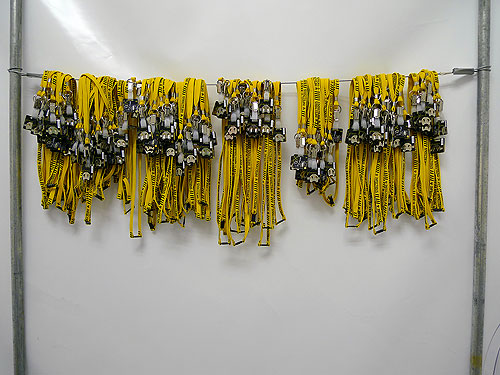 A bunch of RFID tags ready to be distributed at the entrance. 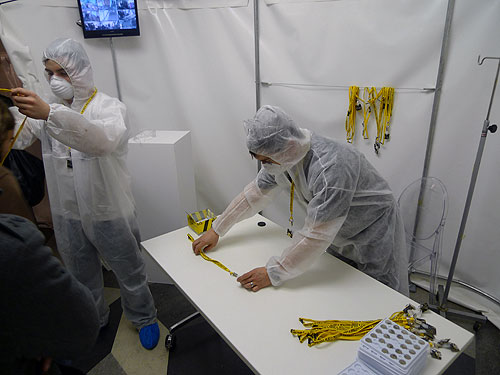 Handing out the RFID tags. 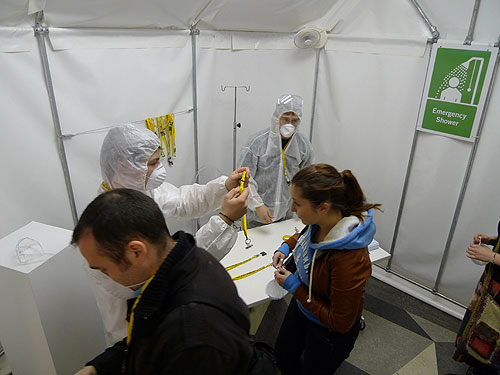 Handing out the RFID tags. 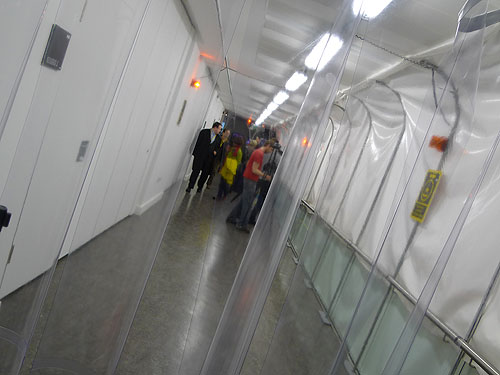 The tunnel contains alarm effects triggered by nearby infected tags.  Nearing the end of the tunnel with the disinfection stations. 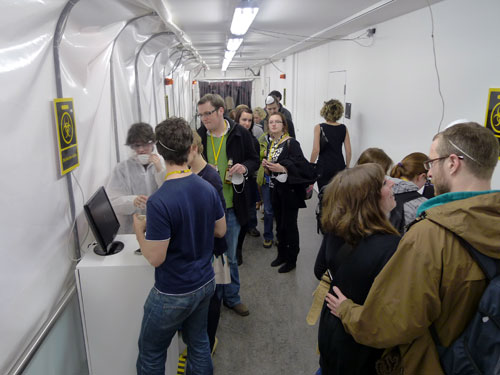 Queuing to get healed at the disinfection stations. 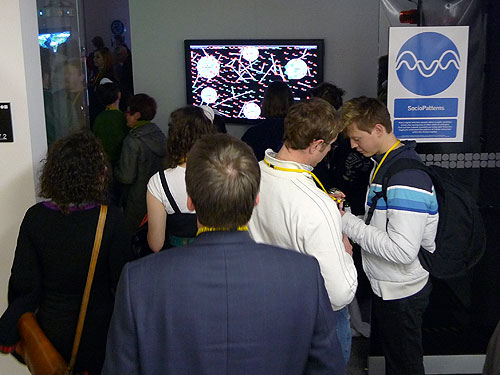 The visualization at the end of the tunnel during the crowded opening event. 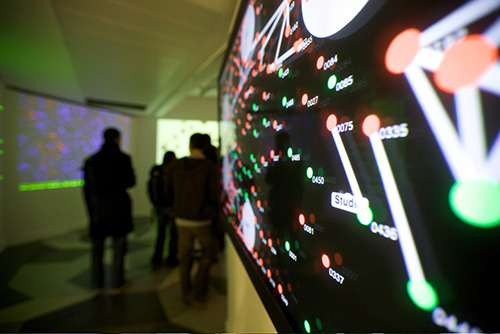 Close-up of real-time visualization in exhibition. Acknowledgements
|
NEWSNew data sets published: co-presence and face-to-face contactsThrough a publication in EPJ Data Science, we have released several new data sets of different types. These datasets can be found on Zenodo. On the one hand, we have released new temporally resolved data on face-to-face interactions collected in
In addition, we release data sets describing the temporally resolved co-location of individuals, where co-location of two individuals at time t means that the same exact set of readers have received signals from both individuals at time t. Data can be found on our website or on Zenodo. Obviously, the co-location data corresponds to a coarser spatial resolution than the face-to-face data, and we have compared the corresponding data in terms of structure and when used in data-driven simulations of disease propagation models in our paper.
SocioPatterns: measuring animal proximity networksAfter so many measurements concerning humans in different contexts (which we will continue measuring), SocioPatterns has partnered with different institutions to measure proximity networks of animals, ranging from free-roaming dogs to sheep and cows. The goals of the studies range from the study of social networks of animals to the development of better models of disease transmission in animal groups.
School closures to mitigate influenza spread: two studies based on SocioPatterns dataIn order to fight and mitigate emerging epidemics, non-pharmaceutical interventions can become necessary. Among these, school closure is typically regarded as a viable mitigation strategy: children indeed are known to play an important role in the propagation of infectious diseases, due to their high rate of contacts at school. School closure is however a costly measure whose applicability remains uncertain and whose implementation should carefully be weighed on the basis of cost-benefit considerations. In two successive studies published in BMC Infectious Diseases, we have used high resolution data on the contact patterns of children that we collected in a primary school,(i) to define and investigate alternative, less costly mitigation measures such as the targeted and reactive closure of single classes whenever symptomatic children are detected, at the scale of a single school and (ii) to evaluate the effectiveness of several such gradual reactive school closure strategies at the scale of entire municipalities. Our results highlight a potential beneficial effect of reactive gradual school closure policies in mitigating influenza spread. Moreover, the suggested strategies are solely based on routinely collected and easily accessible data (such as student absenteeism irrespective) and thus they appear to be applicable in real world situations. References: Mitigation of infectious disease at school: targeted class closure vs school closure
SUPPORTED BY
|
![SocioPatterns [logo]](http://www.sociopatterns.org/wp-content/themes/sp2/images/header_logo.png)
